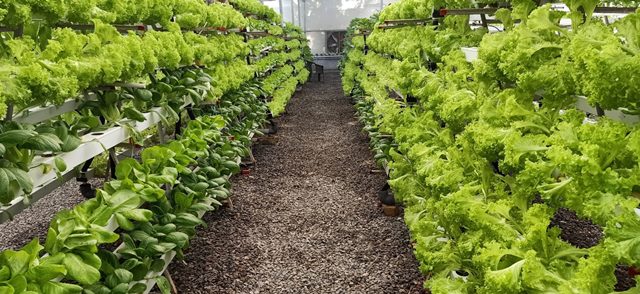Context:
Addressing the escalating global food demand and nutritional needs amidst a growing population and diminishing farmlands, urban agriculture solutions have gained prominence. Countries grappling with sustainable food production and supply challenges are turning to advanced farming methods to ensure future food security and nutrition. In India, hydroponics and vertical farming are emerging as crucial techniques for sustainable and efficient food production, especially given the rising demand for leafy greens and fruits like strawberries and blueberries.
Why Advanced Farming is need of time?
By 2050, the global population will hit 9.8 billion, with 70% living in cities. In India, urban dwellers are expected to reach 53% by then. With limited agricultural land, Urban Farming (UF) methods like vertical and hydroponic farming offer a sustainable solution. The global vertical farming market is projected to reach USD 33.02 billion by 2030, with India's market expected to grow at a CAGR of 25.4% from 2023-2028.
Methods of Hydroponics
Vertical Farming (VF):
● VF departs from traditional soil-based farming, involving stacked layers of crop growth in protected indoor environments. Prof. Despommier is credited as the founder, proposing VF as a solution for nutritional needs in megacities.
● Crops are cultivated in vertically stacked layers within indoor environments, enhancing food production and sustainability. Successful commercial VF ventures exist in European countries, addressing space constraints and urban farming needs.
● Vital for low- and lower-middle-income countries, VF offers solutions for food security, particularly in sub-Saharan Africa and parts of Southern Asia.
Hydroponics in Vertical Farming:
● Hydroponics involves growing plants in nutrient-rich water solutions without soil, utilizing 60-70% less water than traditional agriculture.
● Highly efficient, allowing for quicker and more efficient growth of a diverse range of crops, from leafy greens to fruitful plants.
● Hydroponics gaining popularity among entrepreneurs and farmers for urban farming, rooftop gardening, and commercial cultivation.
● Often integrated into VF systems, contributing to sustainable and compact cultivation practices.
Benefits of Combining Hydroponics and Vertical Farming:
● Enhances efficiency and productivity of resources for food production.
● Successful for urban farming, particularly for leafy green vegetables.
● Facilitates year-round cultivation of crops like lettuce, kale, and spinach in controlled environments.
● Optimizes space and resources, making it an attractive choice for urban food production.
Advantages of Hydroponics with Vertical Farming:
● Indoor vertical farming offers a revolutionary approach to agriculture, utilizing cutting-edge technology to address numerous challenges faced by traditional farming methods. This innovative system utilizes 99% less land compared to conventional farming, making it incredibly space-efficient. Additionally, it requires significantly less water, promoting water conservation. By creating a controlled microclimate indoors, crops can be cultivated year-round regardless of external conditions, ensuring a consistent food supply.
● Moreover, vertical farming minimizes the risk of pests and diseases, reducing reliance on pesticides and fertilizers and promoting sustainable practices. Its location flexibility allows for setups anywhere, cutting down on transportation costs and bringing fresh produce closer to consumers. This accessibility to fresh, local produce ensures a reliable and sustainable food source while enhancing overall productivity per unit area.
● The integration of automated monitoring and control optimizes growing conditions, ensuring optimal plant health and yield. Beyond its agricultural benefits, vertical farming also contributes to urban environmental sustainability and socio-economic development. By operating within urban areas, it reduces the environmental footprint associated with food production and provides economic opportunities, making fresh, healthy food more accessible and enhancing the overall quality of urban life. In summary, vertical farming presents a holistic solution to modern agricultural challenges, offering a pathway towards sustainable food production in a rapidly urbanizing world.
Disadvantages of Hydroponics with Vertical Farming:
● Despite its promising benefits, indoor vertical farming faces several challenges that currently hinder its widespread adoption. One of the primary obstacles is the high infrastructure costs associated with setting up and maintaining indoor farming facilities. The significant initial investment required can deter potential investors and farmers from embracing this technology on a larger scale.
● Another challenge is the labor intensiveness of indoor vertical farming. Operating such facilities demands a highly educated and skilled workforce, which can lead to elevated labor expenses. This reliance on specialized labor further adds to the overall cost of production.
● Additionally, indoor vertical farming is energy-intensive due to the need for artificial lighting and climate control systems. The reliance on these energy sources contributes to higher production costs, affecting the economic viability of indoor farming operations.
● Pollination poses another hurdle as indoor farms often lack natural pollinators, which can result in challenges such as poor fruit quality or the need for alternative pollination methods.
● Furthermore, the range of crops suitable for commercial cultivation in indoor vertical farms is somewhat limited, with a focus primarily on leafy greens and microgreens. This limitation restricts the diversity of produce that can be grown through this method.
● Lastly, indoor vertical farming requires continuous attention and upkeep, including regular maintenance of equipment and monitoring of growing conditions. This ongoing maintenance adds to the operational demands and costs associated with indoor farming.
● Despite these challenges, ongoing advancements in technology and practices within the indoor farming sector aim to address these issues, making indoor vertical farming more economically feasible and scalable in the future.
Conclusion
Vertical farming, utilizing affordable shipping containers and abandoned warehouses, offers sustainable solutions to urban agriculture challenges. Collaborative research is crucial for integrating current technology practices for increased sustainability. Hydroponics maximizes resource use, enables year-round crop production, and reduces waste, promoting sustainability. Integration of smart technologies enhances agricultural productivity. Supportive policies and incentives are needed for widespread adoption, encouraging investment, and promoting urban agriculture through startups.
|
Probable Questions for UPSC Mains Exam-
|
Source: Indian Express







